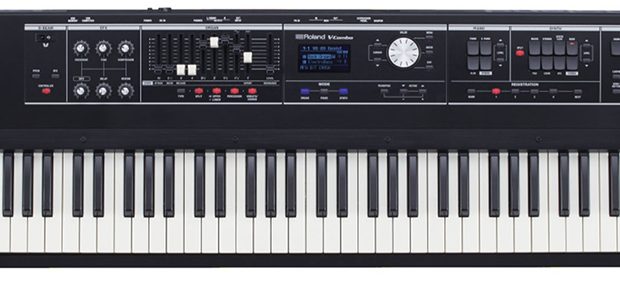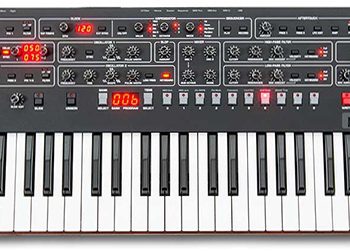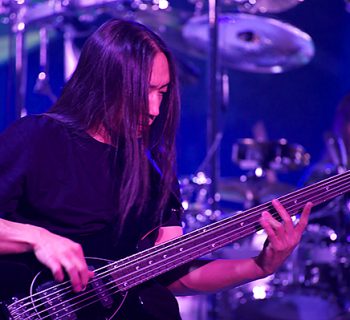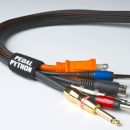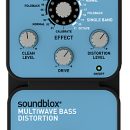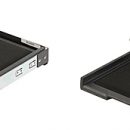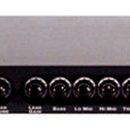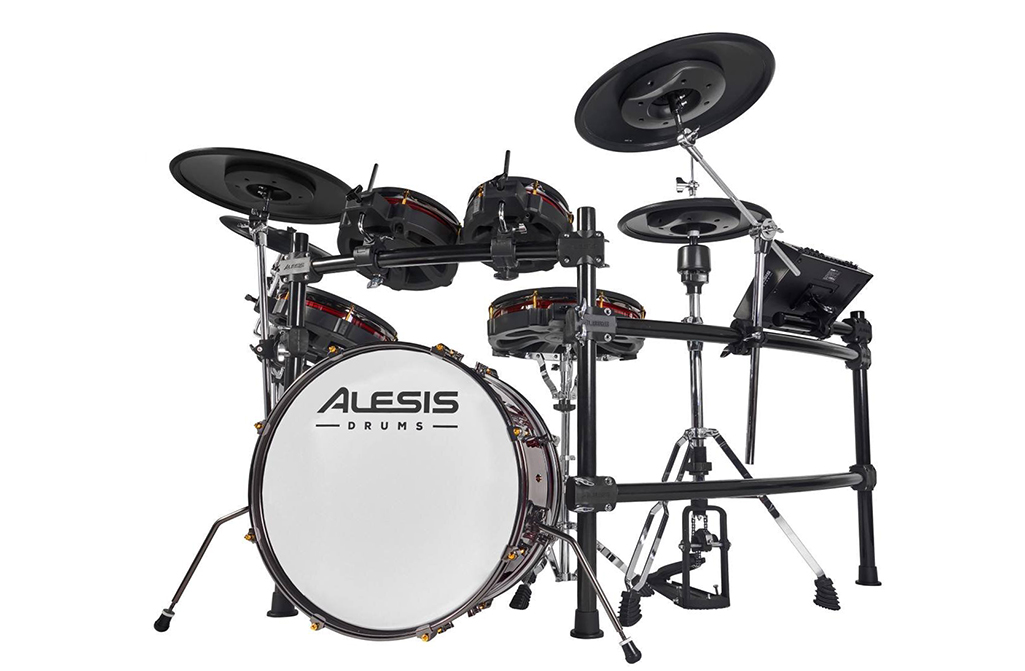When we first heard Roland’s VR-09 at the 2013 Winter NAMM, we were quite impressed with its sound. Designed to be a live performance keyboard that includes all the meat and potatoes for nearly any gig situation, the VR-09 does quite a good job at delivering the goods. Covering organs (with drawbars!), acoustic and electric pianos, synths, strings, basses, brass, drums, and a few other goodies, there aren’t many things that seem to be left out. What is left out is the weight—this keyboard is only twelve pounds, and you can run it on eight AA batteries! You can even connect a USB WiFi adapter and wirelessly connect the VR-09 to your iPad to use a full-screen sound editor. Finally, for what you get, a street price under $1,000 USD makes the VR-09 even more impressive.
Roland continues to tweak and improve the operating system. In fact, while writing this review, Roland released an upgrade to the operating system (version 1.03). This seemingly minor update added an additional 25 electric piano and synth sounds, while adding additional features such as being able to load single sounds (as opposed to only banks) and smoother transitions when changing sounds (we started with version 1.0). Existing owners should upgrade at once.
Features
In this era of complexity, something easy, simple, and quick is incredibly refreshing. Roland has designed the VR-09 to be “grab and go.” By having dedicated buttons/knobs/sliders, you don’t have to dig through menus at the gig. Just select your sound and do what you want in real time.
In the center of the keyboard is a screen with three buttons below for instant access to the main modes of piano, organ, and synth. Next to this on the right is a Value dial to help you scroll through sounds, options, etc., as well as dedicated buttons to transpose pitch, cursor selector, and octave up or down.
To the right of all this is your piano section. Here, you’ll find four buttons, each representing a collection of approximately ten sounds. The selections are acoustic piano, electric piano, clav, and “others” (which represents harmonica, accordion, harpsichord, and similar).
Going further to the right, there are two more sections. The synth section has eight buttons: brass, strings, synth lead, bass, pad, choir, sfx (various noises and sound effects), and others (representing vibraphone, marimba, Glockenspiel). Next to this is the drum section, containing seventeen kits (including many from the well-honored TR family), pre-programmed drum patterns, a song player (for files on a USB stick), and a looper (which allows you to record your playing and, well, loop it).
Below the piano and synth sections is the Bank and Registration section. The VR-09 has 25 banks of four registrations each. A registration is essentially a snapshot of the synth’s current parameters, so this is where, for example, you can store you commonly used presets, splits, etc., for much faster access than scrolling through all the sounds.
Looking to the left side of the LCD screen, you’ll find the organ section. Here, there are nine drawbars (plus an additional one for overall levels), and dedicated buttons for percussion, vibrato/chorus, and upper/lower buttons that enable you to use another keyboard as a lower manual. Near the pitch bend wheel are dedicated buttons for the rotary sound, including fast/slow and on/off. For organ players who love pedals, there is even a dedicated input for a PK-9 MIDI pedalboard.
Another cool feature: the drawbars also double as sliders for the synth section, and are labeled as such: attack, delay, release, cutoff, and resonance.
To the left of the drawbars is the effects section, which consists of six rotary knobs for overdrive, tone, compressor, delay, reverb, and MFX. When you choose a preset, the LCD screen (at the bottom of the display) shows which effect is already assigned (i.e., chorus). Simply turning the MFX knob will automatically adjust that parameter’s effect. No digging into menus—just tweak!
Next to the effects section is Roland’s now-ubiquitous D-Beam. While perhaps not everyone’s cup of tea, it does allow for interesting control in theremin-esque way. There are dedicated buttons for assigning the D-Beam’s functions to pitch, sound effects (i.e., move your hand closer to the D-Beam, and an explosion sound will go off; however, we enjoyed the 1980’s scratch sound much more), and controller (which lets you assign the D-Beam to modulation, for example).
The last section on the left contains a covered USB port. Insert a USB stick to load patches, songs, and perform firmware updates. Once you put your stick in, there is a hood that covers it to protect your stick—a very nice touch, as we tend to worry about USB sticks in live situations where tight performance spaces or close proximity to bar patrons leave us on edge.
Finally, the back ports include a second USB port to connect to your computer, power switch and jack, phones, L/R output jacks, input jack (just a play-through, not for sampling), pedalboard input, MIDI In/Out (no Thru), and expression and damper pedal jacks. There are holes on the top of the keyboard to attach a music stand, and models for the FP-50 and FP-80 can be used.
A word about the keyboard itself: the VR-09 has a light and fast, synth-action keyboard. While typical of synths at this price point, you may want a second keyboard controller with weighted keys in your rig to get the most out of the great acoustic piano sounds on the VR-09. Sadly, the VR-09 does not have aftertouch.
Usability
The idea behind the Roland VR-09 is “grab and go,” and the keyboard is largely successful in that role. You can be plugged in at the gig and playing in less than a minute if necessary. Startup time was only a few seconds, and we were automatically placed in piano mode with “GrandPianoV” being the default startup sound. Want a different piano preset? Turn the dial. Want an EP sound? Press the EP button. Want an organ sound? Press the Organ button. Want more overdrive? Turn the overdrive knob. It’s really that simple.
We liked that whenever we moved the physical organ drawbars, we also saw a graphical representation on the LCD screen. In fact, whenever we changed any parameter, the LCD showed us the corresponding value.
Want to split the keyboard? Press the split button, and the display shows you the sounds for upper and lower halves. Want to layer? Just press any two of the organ/synth/piano buttons at the same time. Yes, you can layer any sound with the organ sounds too.
To edit the actual sounds, there’s an iPad-specific app that enables you to do just that. However, you need to purchase separately Roland’s wireless USB stick adaptor (model WNA1100-RL), a Netgear WNA-1100, or you can use a wired connection via Apple’s Camera Connector Kit. Considering the computer USB interface, we’re surprised there wasn’t any software editor available to run on the computer.
The keyboard has a very light feel to it, and doesn’t have quite the same feel as what you’ll find on more premium keyboards in the Roland lineup. It’s certainly playable—and not fragile-feeling, but it’s also not as solid feeling as other keyboards in our Roland collection ranging from the XP-series keyboards to the V-Synth GT.
Sound
In the VR-09, Roland is not trying to give you thousands of sounds as you’d find in one of their workstation products. Rather, the goal here is simply to deliver a manageable subset of great sounds for easy live and studio use. To that end, Roland definitely achieves the design goal.
While we prefer weighted keys in certain performance situations, the acoustic piano sounds themselves are quite nice. The EP pianos, which Roland has traditionally done well, are also quite good. There are, however, an EP or two that we wish the tone transitions were a little smoother—i.e., when the Rhodes tone changes to more of a bark when you hit the key harder. This can be somewhat tweaked on the synth itself via options under the “keyboard” menu, and we suspect even more can be done via the iPad app (which we weren’t able to test). However, outside of this subtle gripe that we notice—there’s a real Rhodes in one of our studios, the Rhodes, Wurlis and Clavs all sound good, and the effects that contribute to their famous tones—phaser, chorus, vibrato, overdrive, etc.—are all provided, and adjustable in an immediate, easy-to-tweak way.
Moving to the synth section, despite the VR-09 only having hundreds of sounds (as opposed to, say, thousands), there is a good selection of brass, pads, leads, strings, and bass, to cover just about anything you would need on a gig. Roland has traditionally done strings well, and the VR-09 is no exception. There are quite a few selections from the Juno and Jupiter series, and Roland does not hide their affinity for the ‘80s by including patches appropriately named “Jump.” We enjoyed the lead selections, many of which were edgy and modern, and when used with the D-Beam controller, they put a whole new spin on what you can do live (i.e., pitch bends and modulations while you’re soloing).
Of course, you must be wondering about those organ sounds by now! Well, the quality of the organ sounds depends on your frame of reference. Do they sound good? Absolutely. Do they sound better than the significantly more expensive organs from the competition? No. But they get you 90% of the way there. In some cases, you get what you pay for (a $3,000 organ better sound unbelievably real), but make no mistake—you’re getting an awful lot of very good sound at a relatively inexpensive price in the VR-09.
Straight-up organ doesn’t paint the whole picture, though. Adding your own tweaks, like adjusting drawbar settings or effects (i.e., chorus, leslie), can make a big difference (in a good way) in what you are hearing, so don’t be afraid to turn some knobs! For the most part, we thought the rotary simulation was quite good, and in a rock mix live would sound excellent.
Let’s talk more about those “Registrations.” As mentioned earlier, there are 25 banks of four registrations each, essentially representing the entire “state of the synth” when saved. You can think of these as a place to store your favorite presets and all their parameters. While you can go to, for example, the synth section, press the string button, and scroll through (give or take) a dozen presets, there are many more factory presets that are available in the registration area. This is where we found some of the better organ sounds, which goes to further reinforce there’s a lot that can be done to beef up sounds if you take your time with them. Additionally, this is an area in which to load new sounds, such as “The Cover Band Collection,” an optional sound bank consisting of thirty-two sounds based on classic songs dating all the way back to the ‘60s. Roland has a website at www.axial.roland.com where users can download additional patch libraries.
We were least enthusiastic about the drum/looper section, which is not meant to imply that we don’t like it—it’s just the least significant aspect of this keyboard. The drums sounds are very good, and we love the inclusion of TR-series sounds. The Looper allows for around 15-20 seconds of sampling to create multilayered grooves. For example, you can play and record a piano part, than overdub a bass line, then overdub a horn section, and so on. These grooves can then be saved to a USB stick. While admittedly fun, we would have preferred the inclusion of an arpeggiator.
Documentation and Product Support
The VR-09 comes with a printed instruction manual—which is to be expected, but realistically, things are so simple and straightforward operating this keyboard that you’re probably not going to need it for much. We found plenty of additional support info on the Roland website as well.
Price
The Roland VR-09 (MSRP $1,165) sells for just under $1,000 street. Easy on the wallet, your back, and your brain, the VR-09 is a great choice for many pro musicians. While the lack of weighted keys and an arpeggiator may be a turnoff to some, when used as a second synth paired with one that has those capabilities, you may have all that you need in this one box. In fact, Roland advertises using the VR-09 as a second keyboard paired with the weighted RD-64 (see review here). Fortunately, there is enough capability available in the VR-09 that you can easily get through a gig with it alone.
Contact Information
Roland
www.Rolandus.com
| Evaluation Short List: |
|

